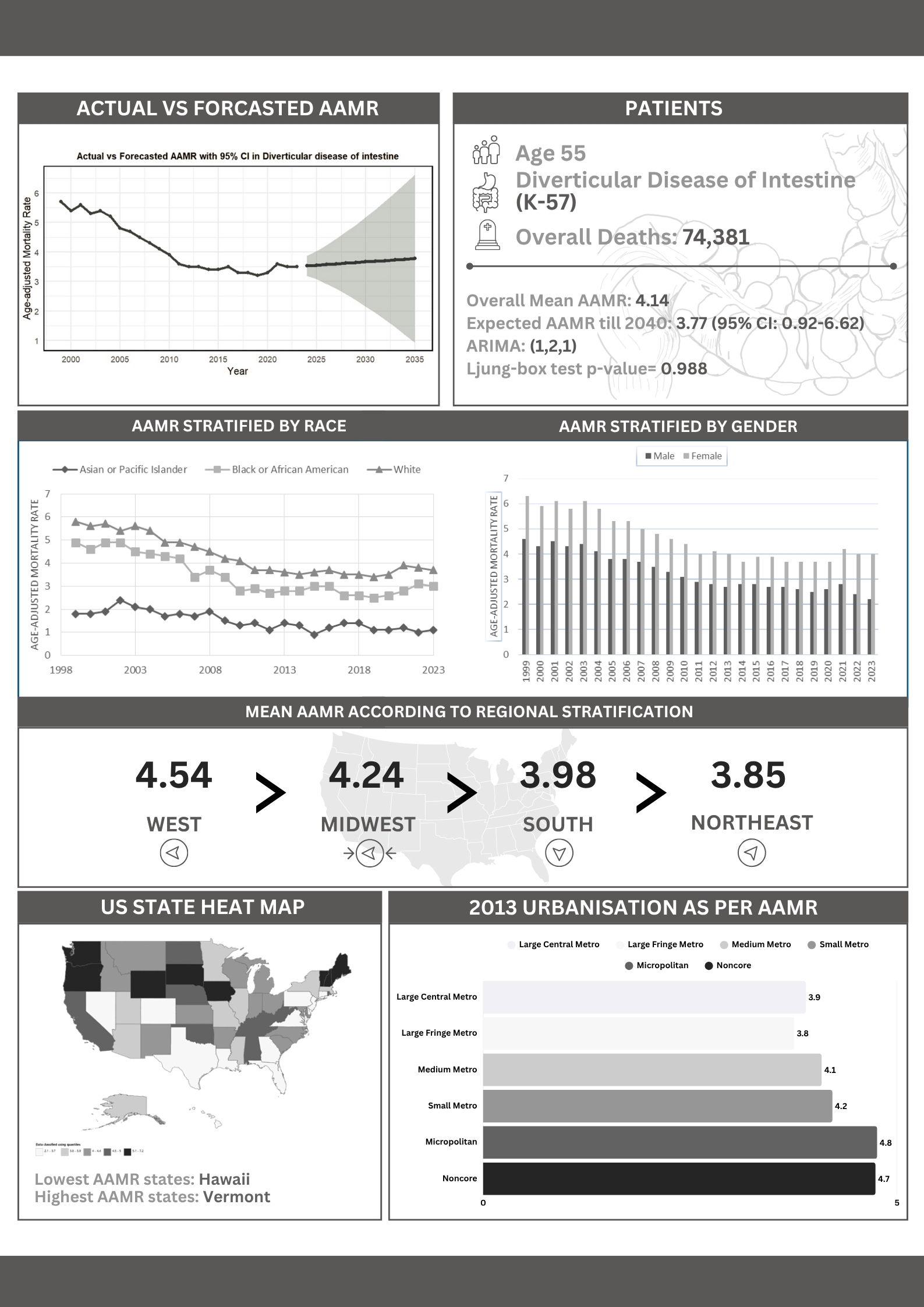Tuesday Poster Session
Category: Colon
P4571 - From Past to Prediction: Disparities in the US Mortality Trends in Diverticular Disease of Intestine Using CDC WONDER and ARIMA-Model (1999-2035)
Tuesday, October 28, 2025
10:30 AM - 4:00 PM PDT
Location: Exhibit Hall

Usman Afzal, MD (he/him/his)
MedStar Georgetown University Hospital
Washington, DC
Presenting Author(s)
Usman Afzal, MD1, Anfal Hamza, MBBS2, Atif Nawaz Malik, MBBS2, Arbaz Hassan, MBBS2, Waqas Ahmed, MBBS2, Talha Sajjad, MBBS, MD2, Aiza Shafique, 3, Abdul Haseeb, 4, Saifullah Khan, 5, Iqra Baig, 6, Muhammad Umair Choudhary, MBBS2
1MedStar Georgetown University Hospital, Washington, DC; 2Sheikh Zayed Medical College, Rahim Yar Khan, Pakistan, Rahim Yar Khan, Punjab, Pakistan; 3Sheikh Zayed Medical College, Rahim Yar Khan, Rahim Yar Khan, Punjab, Pakistan; 4Health Department, Government of AJK, Muzaffarabad, Azad Kashmir, Pakistan; 5Dow Medical College, Karachi, Sindh, Pakistan; 6Shiekh Zayed Medical College, Rahim Yar Khan, Sadiqabad, Punjab, Pakistan
Introduction: Diverticular disease affects nearly half of the older U.S. population, with approximately 25% developing diverticulitis and its complications. Despite advancements in diagnostics and outpatient care, the effect on long-term mortality remains unclear. This study aims to evaluate and predict diverticulitis-related mortality trends among U.S. adults aged ≥55 from 1999 to 2035.
Methods: Data were extracted from the CDC WONDER database for individuals aged ≥55 years with diverticulitis (ICD-10: K57) listed as the cause of death. Age-adjusted mortality rates (AAMRs) were calculated and stratified by sex, race/ethnicity, U.S. Census regions, and 2013 urbanization levels. Annual Percent Change (APC) with 95% confidence intervals (CI) was estimated using Joinpoint regression; p < 0.05 was considered statistically significant. Autoregressive Integrated Moving Average (ARIMA: 1,2,1) approach and Ljung-box test were applied to predict AAMRs till 2035.
Results: From 1999 to 2023, diverticulitis caused 74,381 deaths with overall AAMR of 4.14, with 72.7% occurring in medical facilities. Expected AAMR till 2035 is 3.77 (95% CI: 0.92-6.62; Ljung-box test p-value= 0.988). An increasing trend was observed from 2019 to 2023 (APC: 2.25, 95% CI: 0.16–5.97, p = 0.031). From 2003–2013, males showed a decreasing trend (APC: –4.50, 95% CI: –8.36 to –3.81, p = 0.014), mirrored by females from 2003–2014 (APC: –4.17, 95% CI: –9.40 to –1.78, p = 0.036). A sharp decline in male mortality was noted from 2021–2023 (APC: –8.93, 95% CI: –15.75 to –1.56, p = 0.001). Asians/Pacific Islanders showed a consistent decline (APC: –3.02, 95% CI: –3.82 to –2.09, p < 0.001). Whites declined from 2003–2013 (APC: –4.44, 95% CI: –5.47 to –3.93, p < 0.001). Hispanics (1999–2015) and non-Hispanics (2004–2013) also showed significant decreases (APC: –4.12 and –4.62, respectively; p < 0.01). The Midwest had the steepest regional decline from 2007–2013 (APC: –6.52, 95% CI: –11.45 to –4.58, p = 0.004). The South and West declined from 1999–2014 (APC: –4.36 and –3.85; p < 0.001). The sharpest urban decline was in Large Fringe Metros (2003–2012) (APC: –5.56, 95% CI: –11.06 to –1.04, p = 0.043).
Discussion: Mortality from diverticulitis has increased since 2019, despite prior declines, with persistent disparities by sex, race, region, and urbanization. These findings emphasize the need for ongoing surveillance and focused public health interventions.

Figure: Trends of Age Adjusted Mortality Rates in Diverticulitis
Disclosures:
Usman Afzal indicated no relevant financial relationships.
Anfal Hamza indicated no relevant financial relationships.
Atif Nawaz Malik indicated no relevant financial relationships.
Arbaz Hassan indicated no relevant financial relationships.
Waqas Ahmed indicated no relevant financial relationships.
Talha Sajjad indicated no relevant financial relationships.
Aiza Shafique indicated no relevant financial relationships.
Abdul Haseeb indicated no relevant financial relationships.
Saifullah Khan indicated no relevant financial relationships.
Iqra Baig indicated no relevant financial relationships.
Muhammad Umair Choudhary indicated no relevant financial relationships.
Usman Afzal, MD1, Anfal Hamza, MBBS2, Atif Nawaz Malik, MBBS2, Arbaz Hassan, MBBS2, Waqas Ahmed, MBBS2, Talha Sajjad, MBBS, MD2, Aiza Shafique, 3, Abdul Haseeb, 4, Saifullah Khan, 5, Iqra Baig, 6, Muhammad Umair Choudhary, MBBS2. P4571 - From Past to Prediction: Disparities in the US Mortality Trends in Diverticular Disease of Intestine Using CDC WONDER and ARIMA-Model (1999-2035), ACG 2025 Annual Scientific Meeting Abstracts. Phoenix, AZ: American College of Gastroenterology.
1MedStar Georgetown University Hospital, Washington, DC; 2Sheikh Zayed Medical College, Rahim Yar Khan, Pakistan, Rahim Yar Khan, Punjab, Pakistan; 3Sheikh Zayed Medical College, Rahim Yar Khan, Rahim Yar Khan, Punjab, Pakistan; 4Health Department, Government of AJK, Muzaffarabad, Azad Kashmir, Pakistan; 5Dow Medical College, Karachi, Sindh, Pakistan; 6Shiekh Zayed Medical College, Rahim Yar Khan, Sadiqabad, Punjab, Pakistan
Introduction: Diverticular disease affects nearly half of the older U.S. population, with approximately 25% developing diverticulitis and its complications. Despite advancements in diagnostics and outpatient care, the effect on long-term mortality remains unclear. This study aims to evaluate and predict diverticulitis-related mortality trends among U.S. adults aged ≥55 from 1999 to 2035.
Methods: Data were extracted from the CDC WONDER database for individuals aged ≥55 years with diverticulitis (ICD-10: K57) listed as the cause of death. Age-adjusted mortality rates (AAMRs) were calculated and stratified by sex, race/ethnicity, U.S. Census regions, and 2013 urbanization levels. Annual Percent Change (APC) with 95% confidence intervals (CI) was estimated using Joinpoint regression; p < 0.05 was considered statistically significant. Autoregressive Integrated Moving Average (ARIMA: 1,2,1) approach and Ljung-box test were applied to predict AAMRs till 2035.
Results: From 1999 to 2023, diverticulitis caused 74,381 deaths with overall AAMR of 4.14, with 72.7% occurring in medical facilities. Expected AAMR till 2035 is 3.77 (95% CI: 0.92-6.62; Ljung-box test p-value= 0.988). An increasing trend was observed from 2019 to 2023 (APC: 2.25, 95% CI: 0.16–5.97, p = 0.031). From 2003–2013, males showed a decreasing trend (APC: –4.50, 95% CI: –8.36 to –3.81, p = 0.014), mirrored by females from 2003–2014 (APC: –4.17, 95% CI: –9.40 to –1.78, p = 0.036). A sharp decline in male mortality was noted from 2021–2023 (APC: –8.93, 95% CI: –15.75 to –1.56, p = 0.001). Asians/Pacific Islanders showed a consistent decline (APC: –3.02, 95% CI: –3.82 to –2.09, p < 0.001). Whites declined from 2003–2013 (APC: –4.44, 95% CI: –5.47 to –3.93, p < 0.001). Hispanics (1999–2015) and non-Hispanics (2004–2013) also showed significant decreases (APC: –4.12 and –4.62, respectively; p < 0.01). The Midwest had the steepest regional decline from 2007–2013 (APC: –6.52, 95% CI: –11.45 to –4.58, p = 0.004). The South and West declined from 1999–2014 (APC: –4.36 and –3.85; p < 0.001). The sharpest urban decline was in Large Fringe Metros (2003–2012) (APC: –5.56, 95% CI: –11.06 to –1.04, p = 0.043).
Discussion: Mortality from diverticulitis has increased since 2019, despite prior declines, with persistent disparities by sex, race, region, and urbanization. These findings emphasize the need for ongoing surveillance and focused public health interventions.

Figure: Trends of Age Adjusted Mortality Rates in Diverticulitis
Disclosures:
Usman Afzal indicated no relevant financial relationships.
Anfal Hamza indicated no relevant financial relationships.
Atif Nawaz Malik indicated no relevant financial relationships.
Arbaz Hassan indicated no relevant financial relationships.
Waqas Ahmed indicated no relevant financial relationships.
Talha Sajjad indicated no relevant financial relationships.
Aiza Shafique indicated no relevant financial relationships.
Abdul Haseeb indicated no relevant financial relationships.
Saifullah Khan indicated no relevant financial relationships.
Iqra Baig indicated no relevant financial relationships.
Muhammad Umair Choudhary indicated no relevant financial relationships.
Usman Afzal, MD1, Anfal Hamza, MBBS2, Atif Nawaz Malik, MBBS2, Arbaz Hassan, MBBS2, Waqas Ahmed, MBBS2, Talha Sajjad, MBBS, MD2, Aiza Shafique, 3, Abdul Haseeb, 4, Saifullah Khan, 5, Iqra Baig, 6, Muhammad Umair Choudhary, MBBS2. P4571 - From Past to Prediction: Disparities in the US Mortality Trends in Diverticular Disease of Intestine Using CDC WONDER and ARIMA-Model (1999-2035), ACG 2025 Annual Scientific Meeting Abstracts. Phoenix, AZ: American College of Gastroenterology.
